
President Donald Trump’s California-related water policy hasn’t always been thoughtfully executed, as the fracas over his ordered water releases early this year to help with the Los Angeles wildfires made clear. The decision was hastily made, didn’t help firefighting efforts and squandered water that Central Valley farms will need as the dry season takes hold.
Nevertheless, the president’s instincts are correct. California faces repeated droughts, with state water policy prioritizing environmental concerns over the needs of farmers and consumers. This approach hasn’t done much to improve the environment or boost fish populations. So Trump is right to shift priorities on federally managed projects.
The latest news is heartening, as it points toward building a project that has been discussed for decades: raising Shasta Dam by 18.5 feet. The nation’s eight-tallest dam, Shasta was completed in 1945 and stands at 602 feet. It was originally designed to be 800-feet tall. Although 550 miles from Los Angeles, its future could have a direct impact on Southern Californians.
Given its huge size, raising the dam by that small amount would be like building a new reservoir 85% the size of Lake Tahoe. As CalMatters reported, the administration “has yet to explicitly order the Shasta Dam to be enlarged,” but “recent actions … signal that he is moving in that direction.” He issued an executive order calling for expanding water storage—and a $2-billion earmark could fund the project (although it doesn’t specify Shasta).
It’s run by the Bureau of Reclamation, so the feds have proper authority to do this. A report from the agency notes that Shasta’s expansion would create water storage that can supply farms as well as municipal and industrial users and reduce flooding. It also expects the project to help fish populations by increasing the volume of cold-water releases on the Sacramento River. It’s opposed, of course, by all the usual suspects who complain about most water-infrastructure projects.
We hope the administration follows through with this idea, although we urge it to proceed more carefully than it did with its water releases.



